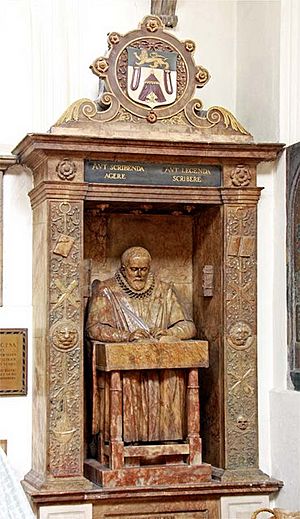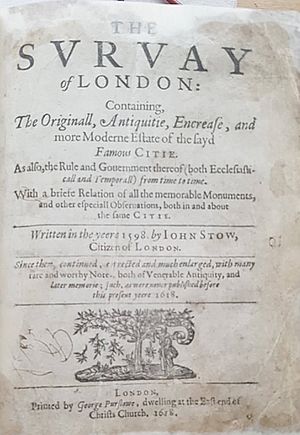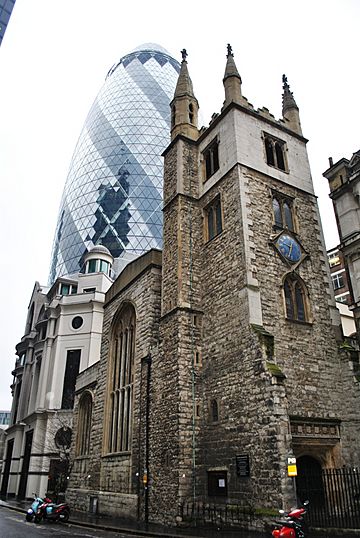John Stow facts for kids

John Stow (born around 1524 or 1525 – died April 5, 1605) was an English historian and antiquarian. An antiquarian is someone who studies old things, like history, old buildings, and ancient customs. Stow wrote many books about English history, starting in 1565. Some of his famous books were The Summarie of Englyshe Chronicles, The Chronicles of England, and The Annales of England. He also wrote A Survey of London (first published in 1598). Historian A. L. Rowse called him "one of the best historians of that age" because he was very hardworking, careful, and always tried to find the truth.
Contents
Life of John Stow
John Stow was born around 1525 in the City of London, in a part called St Michael, Cornhill. This area was right in the middle of London back then. His father, Thomas Stow, made and sold candles as a tallow chandler. Young John used to get milk every morning from a farm nearby. He probably didn't go to a fancy grammar school, but he learned a lot by himself.
Instead of making candles like his father, John Stow became an apprentice and later a freeman of the Worshipful Company of Merchant Taylors, which was a group for tailors. He set up his own business near Aldgate Pump in Aldgate, close to Leadenhall Street and Fenchurch Street.
Around 1560, he started working on his most important book, the Survey of London. Because he was so interested in old things and history, some church leaders became suspicious. In 1569, his house was searched because they thought he had "dangerous and superstitious books." They checked all his books, especially those that might support the old papist (Catholic) religion. But John Stow was able to show them that he was a good Protestant. Another attempt to accuse him was made in 1570, but it also failed.
Around 1570, he moved to the area of St Andrew Undershaft in the Ward of Lime Street. He lived there comfortably until he passed away in 1605.
Stow's Friends and Network
John Stow was friends with many important antiquarians of his time. These included people like Archbishop Matthew Parker, John Dee, and William Camden. He was also part of the first Society of Antiquaries, which started around 1586.
He collected a huge library of old handwritten and printed history books. People called his collection his "storehouse." He was very kind and often let others use his books for their own studies.
John Stow's Personality
People who knew Stow thought highly of him, especially because he was willing to share his research. Sir George Buck said that "honest John Stow" was a very hardworking and curious person who always tried to find out the truth about important people. Edmund Howes described him as having a "pleasant and cheerful face." He was also said to be very polite and helpful to anyone who asked for his advice.
However, Stow also had some disagreements and held onto grudges. He had a long argument with his younger brother, Thomas, about their mother's inheritance. John thought he should get more as the oldest son, while Thomas felt he deserved more because he had cared for their mother. Stow also argued with neighbors and had a well-known disagreement with another historian, Richard Grafton.
Stow's Writings
John Stow published his first book in 1561. It was a new edition of the works of Geoffrey Chaucer, with some parts that had never been printed before.
In 1565, he published his Summarie of Englyshe Chronicles. This book was printed in a small size. A slightly different, even smaller version called Summarie of Englyshe Chronicles ... Abridged came out in 1566. Both books were printed many times during Stow's life and even after he died. The Summarie Abridged mentioned the rival book by Richard Grafton in a negative way, and their disagreement lasted until Grafton died in 1573.
In 1580, Stow published a bigger book called The Chronicles of England. He later made this even larger, calling it The Annales of England. New versions of this book came out in 1592, 1601, and 1605. The last one included events up to just ten days before Stow's own death.
Stow also helped produce other historical books, like a version of Flores historiarum in 1567 and the Chronicle of Matthew Paris in 1571. He also worked on a much larger history of Britain called "A Historie of this Iland." He said it was "ready to the presse" (ready to be printed) in 1592, but it was too big and expensive for any printer to take on. Sadly, this manuscript is now lost.
The Survey of London
The book John Stow is most famous for is his Survey of London, first published in 1598. This book was a detailed guide to London. It was like a tour, going ward-by-ward (like neighborhoods) through the city. It described buildings, how people lived, and the customs of the time. It gives us a unique look at London back then.
A second, updated version came out in 1603. After Stow died, other people added to and updated the book over many years. Today, the 1908 edition by C. L. Kingsford is considered the most important scholarly version.
Later Life and Death
John Stow's writing didn't make him rich, but he accepted his simple life with a happy attitude. The famous writer Ben Jonson once said that Stow joked with two people asking for money, asking them "what they would have to take him to their order" (meaning, what would it cost to join their group of poor people).
From 1579, he received a small payment of £4 a year from the Merchant Taylors' Company. In 1590, he asked the city leaders to let him have the Freedom of the City of London, which would help him save money on expenses. Around the 1590s, William Camden paid Stow £8 a year for life to copy some old notebooks. This was probably a kind way to help his old friend who wasn't well-off. In 1604, King James I allowed Stow to collect donations from people. While this royal support was good, it didn't bring in money fast enough for Stow to enjoy much of it.
John Stow passed away on April 5, 1605. He was buried in the church of St Andrew Undershaft, which is located at the corner of Leadenhall Street and St Mary Axe.
Stow's Manuscripts and Collections
Many of John Stow's original handwritten papers are now kept in the British Library, especially in the Harley Collection. Others are in the Bodleian Library. Some of his notes and old writings were published in 1880.
The books and papers that made up his personal library are now spread out in different places. However, they can often be recognized because of the many notes he wrote in them.
Remembering John Stow
Stow's wife paid for a special monument to him in St Andrew Undershaft church. It's made of marble and alabaster. The monument shows Stow sitting at a desk, writing in a book. Above him is a Latin saying that means: "Blessed is he to whom it is given either to do things that are worth writing about, or to write things that are worth reading about." The statue holds a real quill pen, just like the statue of William Shakespeare in Stratford-upon-Avon.
To honor Stow's lasting importance as the "father" of London history, the quill pen in his statue is replaced regularly. This tradition was mentioned as happening "annually" in 1828. After a break, it was brought back in 1905. Since 1924, a special church service has been held every April for this ceremony, with a historian giving a speech. This continued even during the Second World War. The service couldn't happen in 1992 or 1993 because the church was damaged by a bomb. It restarted in 1994, but from 1996 to 2017, it was held only once every three years. The service planned for 2020 was canceled due to the COVID-19 pandemic. The Merchant Taylors' Company and the London and Middlesex Archaeological Society work together to organize these services, and the Lord Mayor of London or the Master Merchant Taylor takes turns replacing the quill.
Stow's book, Survey of London, also gave its name to the modern Survey of London project. This is a huge, multi-volume study of London's architecture, which started in 1894 and is still going on today.




